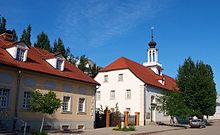Sarepta (Volgograd)
Sarepta was a settlement of the Moravian Brethren in the Astrakhan governorate . Today the open-air museum Old Sarepta in Volgograd commemorates them .
history
Invited by Catherine II to the Russian Empire , the first five fellow believers from Germany reached the area of Tsaritsyn , today's Volgograd, with their Russian companions in August 1765 . They could choose their land "for perpetual property" themselves and were allowed to set up self-government . On the northwest bank of the Sarpa , a right tributary of the Volga , Sarepta was created . Although the Kalmyks called the river Sarpa-ta , the place name did not refer to the river, but to the 1st Book of Kings ( 1 Kings 17.9 EU ): " Open up and go to Sarepta ...". 25 km from the Tsaritsyn fortress, the area was on the southwestern bank of the Volga. It extended over 7 Werste (≈ 7 km) along the bank and was 5807 Dessjatinen (about 6388 ha), but in some places unusable due to the salty soil. In 1771 the first reinforcement column arrived with 66 settlers.
The settlement was a copy of Herrnhut in Upper Lusatia . In 1767 the brothers built an aqueduct from the mountains to Sarepta. Exempted from taxes for 30 years from the same year , they devoted themselves primarily to trade and industrial development , to the delight of the Russian government . In 1768 a factory was established that imported and processed half as much regional tobacco . The processing of cotton was most profitable . The Sarpinka , named after the place, was known as a textile beyond the Volga region. The Moravian Colony was also known for its viticulture and flourishing handicrafts . A mineral-rich spring discovered in 1773 brought many visitors and promoted the growth of the settlement. Sarepta became the most important and best known of all German colonies in Russia.
On the edge of the steppe , looting by Kalmyks and attacks by Turks who had come close were to be feared. Therefore the place was fortified in 1769 with ramparts and moats , 6 bastions and 12 cannons . 20 men formed a guard. The relaxed coexistence with the Kalmyks contributed significantly to the fact that these nomads settled down.
In the 19th century, secularization made a Moravian life more and more difficult. In 1892 the last brothers were called back to Herrnhut and Sarepta was given up as a branch of the congregation. What remains is a German Protestant parish of 30,000 Russian Germans . The mustard factory founded by the Herrnhutern still exists and produces, among other things, mustard oil . The Volgograders know it from childhood and therefore like it very much. The Russians from other regions, however, cannot stand it.
Population development
Sarepta's population grew very slowly in the 19th century. The population fluctuated between 1300 and 1500. The birth rate exceeded the death rate at most slightly. In 1901, 2072 people (1338 Germans and 734 Russians) lived in Sarepta.
Museum Alt-Sarepta
In 1989 the teacher Aleksandr Petrow formed a citizens' initiative to restore historic German houses. Petrov drew the local administration's attention to the condition of the houses and tried to get funding. The church was built around 1780 and is the oldest building in Volgograd. The German community takes care of the maintenance of the houses and uses the church for their German-language services . The open-air museum now includes around 15 houses, 8 of which have been renovated.
In 1996, North Rhine-Westphalia donated a library that is maintained and expanded. On January 5, 2013, ARD broadcast a documentary about Volgograd and also reported on the German community. The Musej Staraja Sarepta is in the Ulitsa Isobilnaja 10 in Krasnoarmeisk, which was not incorporated into Volgograd until 1945.
Ulrich Brandenburg , the German ambassador to the Russian Federation , visited Alt-Sarepta 70 years after the Battle of Stalingrad .
Sons and daughters
Were born in Sarepta
- Daniel Heinrich Willy (1786–1861), German lawyer and university professor
- Joseph Christian Hamel (1788–1862), doctor of German descent, natural scientist and technologist in Russian service
- Heinrich Rudolf Wullschlägel (1805–1864), Russian-German clergyman of the Moravian Brethren
- Alexander Becker (1818–1901), Russian-German entomologist and botanist
literature
- Olaf Herwig Hafa : The Sarepta Brethren. A contribution to the history of the Volga Germans. Wroclaw 1936
- Otto Teigeler: The Moravians in Russia. The aim, scope and output of their activities . Vandenhoeck & Ruprecht, Göttingen 2006, ISBN 978-3-525-55837-9 . Online version
- Wolfgang Stratenwerth : One teacher and a thousand students. Joseph Hamel's documentation on “mutual teaching” (Paris 1818). With a detailed biography of Joseph Christian Hamel and an excursus about the Moravian Common Sarepta . 2nd updated, supplemented and corrected edition. edition winterwork (publisher). Borsdorf 2020. ISBN 978-3-96014-663-6
- Wolfgang Stratenwerth: Joseph Christian Hamel 1788–1862. A German doctor, naturalist and technologist from Sarepta in Russian service . Edition Winterwork. Borsdorf 2020. ISBN 978-3-96014-651-3
Web links
- Website of the Alt-Sarepta Museum (Russian, no German version yet)
- Gmelin's journey through Russia 1769/70 (GoogleBooks)
- Pictures from Alt-Sarepta (www.wolgograd-heute.de)
- Museum Altsarepta (eu-asien.de)
Individual evidence
- ↑ a b c d Teresa Tammer: Catherine II. And the Moravian Brethren in Sarepta (Tabularasa)
- ↑ a b O. Teigeler
- ↑ Gmelin
- ↑ Sarpinka
- ↑ JA Güldenstädt: Travels through Russia and in the Caucasus Mountains (1787)
- ↑ a b Communication from Sergei Sabelnikow, Volgograd
- ↑ DNB
- ↑ ARD (youtube) ( Memento from July 23, 2013 in the Internet Archive )
- ↑ Message from the German Embassy in Russia ( page no longer available , search in web archives ) Info: The link was automatically marked as defective. Please check the link according to the instructions and then remove this notice.
Coordinates: 48 ° 31 ' N , 44 ° 31' E
